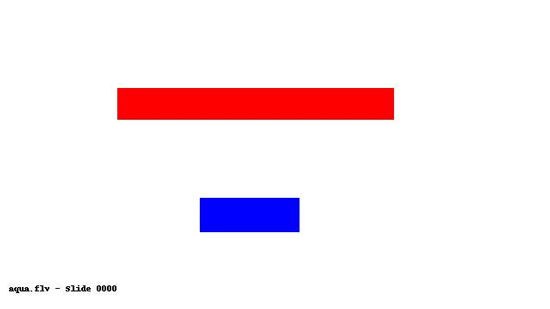Since September of last year, one YouTube channel by the name of “Webdriver Torso” has uploaded over 77,000 videos. Each of the videos has the same format, cycling through 10 “slides” (numbered 0000-0009) over the course of 11 seconds. Each slide displays two rectangles: one blue and one red. In each successive slide, the rectangles change shape and position.
Here is the very first video, uploaded Sept. 23.
Here is the most recent video, uploaded April 9.
As you can see, not much has changed!
The only sounds are digital bleeps and bloops that do not seem to correlate in any obvious way to the arrangement of the shapes: At first it seems that a beep changes to a bloop when the shapes change, but closer attention reveals that this is not the case.
Sometimes there are 10 different bleeps and bloops, just as there are 10 slides; sometimes there are 11 bleeps. There are always, however, 10 slides—so far as I can tell, not having watched all 77,389 videos.

I asked Daily Dot reporter Aja Romano, who has excellent relative pitch, to watch one of these videos and tell me what notes were being played. This clip, she reports, is playing, in order, the notes D, C, B, G, D, D, D, E, G#, B, and A.
“But the pitches are very sharp, fwiw, so that G#, B, A at the end could almost be heard as an A, C, A#/B-flat,” she says.
There does not appear to be a pattern here. But then, this is one video out of more than 77,000. Perhaps the pattern only emerges after the first 10,000.
A Google search for “Webdriver Torso” only turns up results related to the YouTube channel. (We reached out to Webdriver Torso via the YouTube messenger, but have not heard back.) A search for “Webdriver” alone, however, is somewhat more fruitful.

Selenium is a set of tools that help you automate Web-based tasks. According to its site, “it is for automating Web applications for testing purposes, but it is certainly not limited to just that.” One of the tools Selenium offers is something called WebDriver.
“WebDriver is a tool for writing automated tests of websites,” reads the WebDriver FAQ. “It aims to mimic the behavior of a real user, and as such interacts with the HTML of the application.”
So we reached out to the owners of Selenium WebDriver identified in this list of developers. It looked likely that “Webdriver torso” was part of this project, not only because of the shared neologism but also because automation seemed like the only plausible explanation for uploading this quantity of video. But Patrick Lightbody, who has been involved with Selenium since 2005, denied that there was any connection between their WebDriver and Webdriver Torso.
“Those videos look like they are trying to make contact with aliens,” he wrote.

Photo by jd hancock/Flickr (CC By 2.0) | Remix by fern
